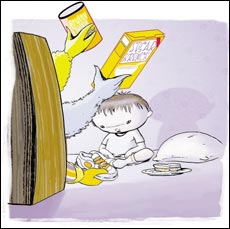
Parents used to fear the TV. After all, it was the great messenger pitching sugared breakfast cereal, health-challenged fast food and anatomically and unattainably perfect playthings. Parents knew of its evils and admonished their offspring for being so easily manipulated by its promises of beauty, status and unbridled happiness.
Then they packed their children's Disney-branded knapsacks with logo-riddled sneakers and drove them to school in their German-engineered cars.
Kids, in turn, observed the influence the television had on their parents.
They could see how its 30-second lessons in consumption foretold the brands in their closets and the dinner on their table. Children learned from their parents; parents learned from their children and by the end of the 20th century, both had come to recognize the omniscient influence television had in getting them to part with their money.I pine for those simpler times. Back then, an ad was an ad was an ad, and point and click and parental control meant turning off the TV.
But folks, advertising ain't what it used to be.
With kids' lives over-programmed, computers as the new playground, a 500-channel universe, PVRs and -- gasp -- kids' TV viewing in a freefall, marketers are reinventing the advertising rule book.
The rebirth of kids' advertising is now called "experiential marketing" and it's so seamlessly integrated with kids' entertainment world, even parents have a hard time seeing the ad through the trees.
Viral, connector, guerrilla, adver-gaming, in-game placement, product placement, e-mail blasts, embedded curriculum integration, forward to a friend -- welcome to the new marketing and advertising toolbox; it's more fun than any kid has a right to have, and often so brilliantly surreptitious, it's virtually impossible to spot the pitch.
Experiential marketing makes parenting a much more challenging job, requiring more time and involvement in your children's media world.Need convincing? Here are a few examples.
* Xbox launches an online promotion called "Xbox Tag." Players are instructed to e-mail friends, inviting them to play tag, and with each hit of the send button, players increase their chances to win Xbox consoles and game titles.
This type of approach is called:
a) Viral marketing -- because your kid will tell two friends, and they'll tell two friends, and so on, and so on, and so on (ad nauseam being the point).
b) Brilliant marketing -- because the company doesn't have to spend heaps of money on television advertising because -- hey, you're doing the advertising for them.
c) Relationship marketing -- it's a way for the company to get up close and personal.
d) All of the above.
* At last year's MTV Video Awards, Jessica Simpson sings and all the kids in the pseudo mosh pit are waving identical K9 clamshell cell phones lighting up the night sky. You think "What's with that? She's not even that good." Could it be:a) Their lighters weren't working.b) The war in Iraq has resulted in a shortage of butane lighter fluid.
c) Marketers at Virgin Mobile handed out hundreds of free cell phones to kids who think wireless experiences are a proxy for real world living.
d) Her husband and Newlyweds co-star Nick Lachey was trying to reach her.
* Cereal companies like Kellogg's and General Mills put CD/DVD ROMs on their cereals targeted at kids. The companies offer several discs in the collection. This strategy is called:a) Loyalty marketing -- get 'em early and you've got 'em for life.
b) Collect-and-swap marketing -- "I'll trade you a Scooby Doo for a Super Mario Bros."
c) Pester power marketing -- "Mom, you can't buy another type of cereal until I have all five CDs in the collection."d) All of the above.
* Your child is playing a game on the wildly successful website called Neopets®. No offensive pop-up or banner ads, here. Instead kids play with advertisers' products -- Disney, Atari, McDonald's, etc. -- which are embedded in the site. (http://demo.neopets.com/presskit). This type of selling:a) Is called adver-gaming or Immersive advertising® and is so stealth-like even Pentagoners play at lunch
b) Is way too much fun to be advertising.
c) Creates a "positive and long-lasting brand impression" with kids who would otherwise be on MSN if these companies were advertising on TV.
d) All of the above.
Welcome to advertising, 21st-century style.Not your usual 30-second product pitch. As participants in this free market, we've swamped our kids in a ubiquitous media culture that's steeped in surreptitious ad forms.As a marketer, I see the brilliance of these tactics.
As a parent and someone who teaches media literacy to kids, I'm not so sure. It's much harder to raise thoughtful, reflective and media-savvy kids when marketers keep embedding their messages.
Faced with these stealth-marketing tactics, it's tempting to throw up our hands and ban every screen in the house. But we're not Luddites; prohibition won't help our kids. In any case, there's no chance marketing to kids will disappear any time soon.
Media savvy is learned through critical analysis and through behaviour -- treating media the way you want your kids to treat it, namely with skepticism.
So ask your kid's teacher what they're doing to help students think through the culture.
Pull up a chair beside your kids and their computer, and start clicking.
You've got your work cut out for you.
Former Winnipegger Debbie Gordon teaches media literacy workshops across Canada.
![]()
